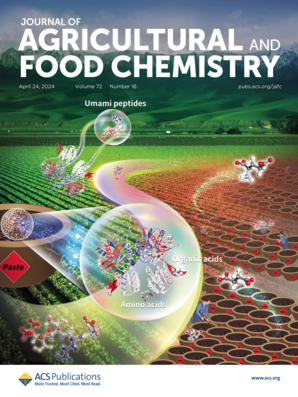IF 5.7
1区 农林科学
Q1 AGRICULTURE, MULTIDISCIPLINARY
引用次数: 0
摘要
本研究旨在从阿拉斯加狭鳕皮(APS)的副产品中鉴定和表征两种具有抗高血压和抗氧化活性的新型双功能肽。结果表明,从阿拉斯加狭鳕皮中鉴定出 59 种肽,其中 GP1(GSAGPAGPSGPRGP)和 GP2(LGDARNSPAPP)这两种肽被认为具有最高的血管紧张素转换酶(ACE)抑制和抗氧化活性。GP1 和 GP2 表现出良好的 ACE 抑制活性(IC50 值分别为 0.166 和 0.177 mmol/L),并能显著降低高血压大鼠的血压。此外,这两种肽都能有效清除 2,2′-卡西诺-双(3-乙基苯并噻唑啉-6-磺酸)(ABTS)自由基(EC50 值分别为 0.273 和 0.629 mg/mL),并保护 HepG2 细胞免受 H2O2 诱导的损伤。分子对接显示,这些肽与 ACE 活性口袋内和入口通道处的氨基酸残基相互作用,显示出混合竞争性抑制模式。这些多肽还能与 Kelch 样 ECH 关联蛋白(Keap1)的 Kelch 结构域结合,从而通过 Keap1-Nrf2 途径促进核因子红细胞 2 相关因子 2(Nrf2)介导的抗氧化酶转录激活。APS 肽具有抑制 ACE 和抗氧化的双重特性,同时还具有较高的胃肠道稳定性,因此可以作为多功能成分用于降压功能食品、营养保健品和肽基水凝胶的开发。本文章由计算机程序翻译,如有差异,请以英文原文为准。

Two Antihypertensive and Antioxidant Peptides Derived from Alaska Pollack (Theragra chalcograma) Skin: In Silico, In Vitro, and In Vivo Investigation
This study aimed to identify and characterize two novel dual-functional peptides with antihypertensive and antioxidant activities from byproducts of Alaska pollock skin (APS). Results showed that fifty-nine peptides were identified from APS, of which two peptides, GP1 (GSAGPAGPSGPRGP) and GP2 (LGDARNSPAPP), were predicted to exhibit the highest angiotensin-converting enzyme (ACE) inhibitory and antioxidant activities. GP1 and GP2 demonstrated favorable ACE inhibitory activities (IC50 values of 0.166 and 0.177 mmol/L, respectively) and significantly reduced blood pressure in hypertensive rats. Additionally, both peptides effectively scavenged 2,2′-casino-bis (3-ethylbenzothiazoline-6-sulfonic acid) (ABTS) radicals, with EC50 values of 0.273 and 0.629 mg/mL and protected HepG2 cells against H2O2-induced damage. Molecular docking revealed that the peptides interacted with amino acid residues within the active pocket and at the entrance channel of ACE, displaying mixed-competitive inhibition patterns. These peptides could also bind to the Kelch domain of Kelch-like ECH associating protein (Keap1), thereby promoting nuclear factor erythroid 2-related factor 2 (Nrf2)-mediated transcriptional activation of antioxidant enzymes through the Keap1–Nrf2 pathway. The dual ACE inhibitory and antioxidant properties of APS peptides, coupled with high gastrointestinal stability, validated their utilization as multifunctional ingredients in antihypertensive functional foods, nutraceuticals, and peptide-based hydrogel development.
求助全文
通过发布文献求助,成功后即可免费获取论文全文。
去求助
来源期刊
CiteScore
9.90
自引率
8.20%
发文量
1375
审稿时长
2.3 months
期刊介绍:
The Journal of Agricultural and Food Chemistry publishes high-quality, cutting edge original research representing complete studies and research advances dealing with the chemistry and biochemistry of agriculture and food. The Journal also encourages papers with chemistry and/or biochemistry as a major component combined with biological/sensory/nutritional/toxicological evaluation related to agriculture and/or food.

 求助内容:
求助内容: 应助结果提醒方式:
应助结果提醒方式:


